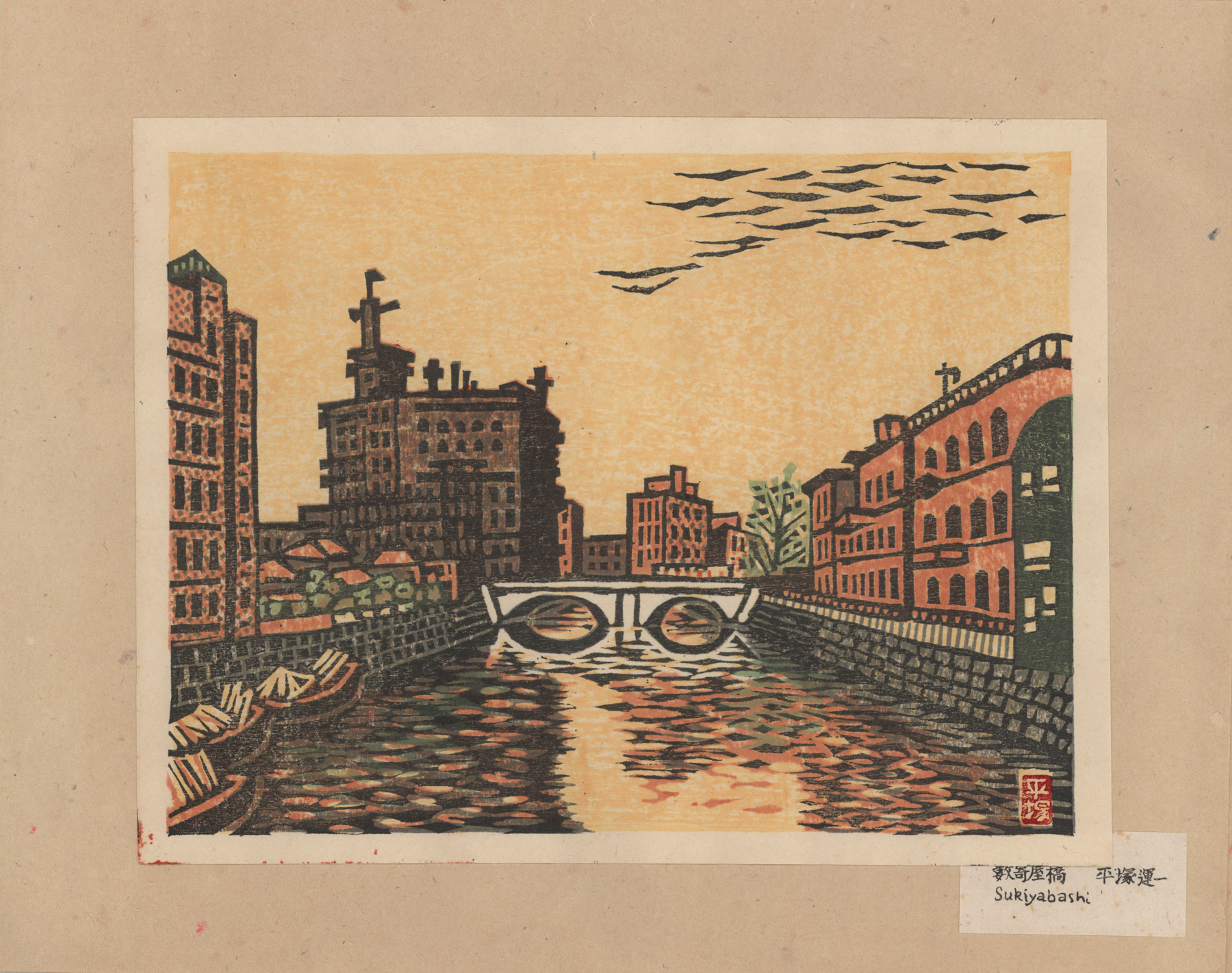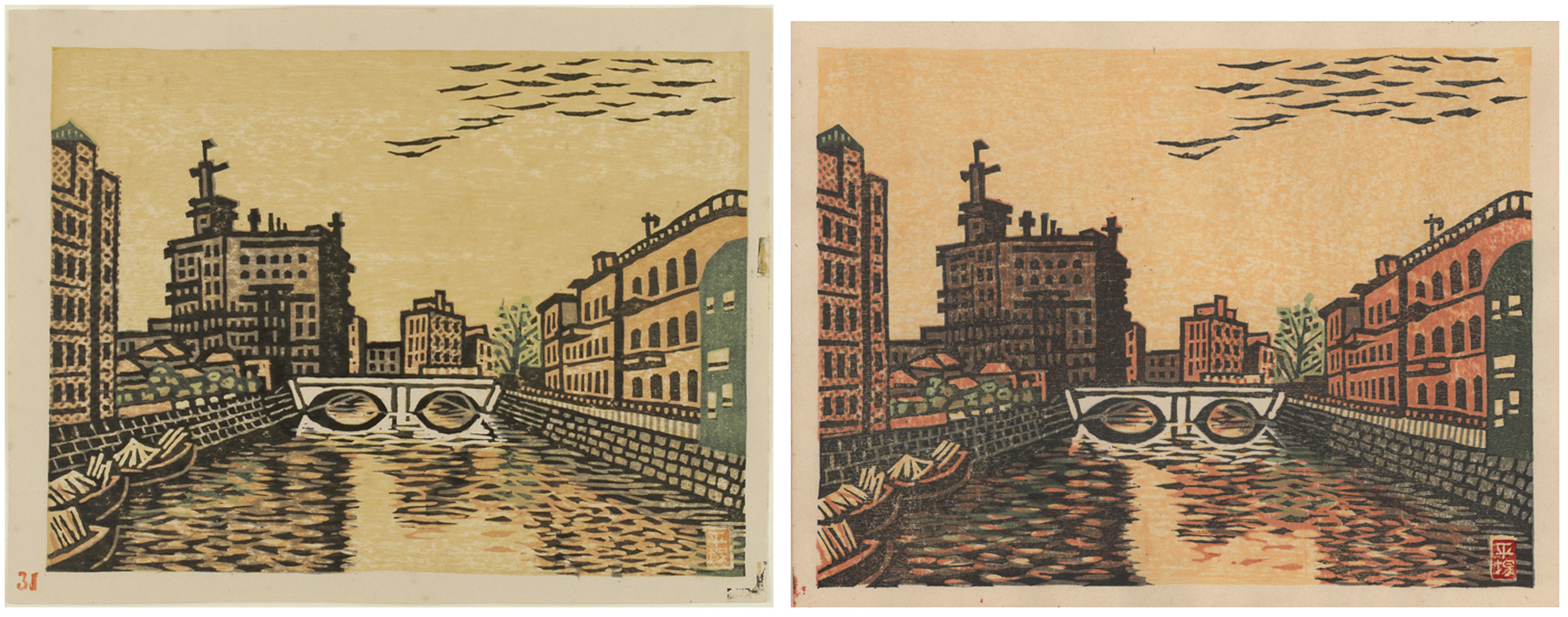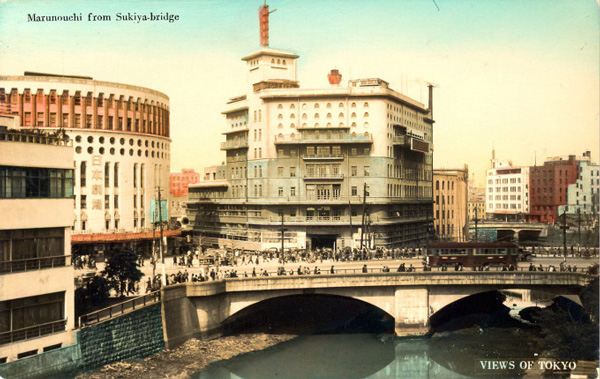About This Print
One of fifteen prints from the 1945 series Scenes of Last Tokyo. This print was one of eight designs for the series which originally appeared in the 1929-1932 series Shin Tokyo hyakkei (One Hundred Views of New Tokyo). (For an image of the 1930 release, see below.) This 1945 print was made from recut blocks. It is one of two designs that Hiratsuka contributed to Scenes of Last Tokyo, the publication of which was orchestrated by Onchi Kōshirō (1891-1955).Source: Japanese Prints During the Allied Occupation 1945-1952, Lawrence Smith, British Museum Press, 2003, p. 60.
Hiratsuka re-used a design he had contributed to One Hundred Views of New Tokyo (Shin Tokyo hyakkei) in October 1930. Visual scrutiny of the two versions suggest the blocks are the same, but noticeably worn in the 1945 version. [My note: Actually, close scrutiny of the two versions will show that at least one of the blocks used was re-cut which confirms Merritt's statement that "According to Hiratsuka... the blocks for his two prints were recarved by Maeda Masao."1] The effect of the later print is lighter and more sunlit, with green tints as in spring, rather than the more muted tones of the original.... In Hiratsuka's print the busy area of Sukiyabashi (the bridge over the canal) is made strangely lonely. The building in the centre is the main office of Asahi Shimbun, one of Japan's biggest newspapers , completed in 1927. The bridge was demolished in 1957, and the canal filled in.
1 Modern Japanese Woodblock Prints - The Early Years, Helen Merritt, University of Hawaii Press, 1998, p. 283.
| Hiratsuka Un'ichi, Sukiyabashi (#31), 10/5/1930 from the series One Hundred Views of the New Tokyo (Shin Tokyo Hyakkei) collection of Carnegie Museum of Art, 89.28.206.8 | Hiratsuka Un'ichi, Sukiyabashi, 12/1945 from the series Scenes of Last Tokyo (Tokyo kaiko zue) IHL Cat. #1571 |
Sukiya Bridge with Asahi Shinbun building in center background with the Nichigeki Theater which opened in 1933 to its left.
Postcard, c. 1933Source: The Artist's Touch, The Craftsman's Hand: Three Centuries of Japanese Prints from the Portland Art Museum, Maribeth Graybill, Portland Art Museum, Oregon, 2011, p. 300.
Sukiyabashi was built in 1929 to cross the outer moat of the castle on the east side. Constructed of concrete with two side-by-side arches, it quickly became a popular tourist attraction and survived until 1958, when the moat was filled in for the construction of a highway through the heart of Tokyo. The tall brick building in the background at left is the Asahi Newspaper building. Hiratsuka's rhythmic chiseling of his blocks creates an impressionistic mosaic of light effects, accented by the white shape of the double-arched bridge, which is printed in reserve.
Source: Terrific Tokyo: A Panorama in Prints from the 1860s to the 1930s, Elizabeth de Sabato Swinton, Worcester Art Museum, 1999. P. 75.
The Citizenry seems on the whole to have been rather pleased with the rebuilding.... Everything had become so cheerful, all that white concrete replacing all that dark plaster and those even darker tiles Sukiya Bridge, west of Ginza, with the new Asahi Shimbun building reflected in its dark waters like a big ship, and the Nichigeki, the Japan Theater, like a bullring, was the place where all the mobo and moga, the modern boys and girls... wanted to have their pictures taken. (Edward Seidensticker, Tokyo Rising)
In this sunny depiction of the reconstructed area in the heart of downtown Tokyo, Hiratsuka reflects the then-prevailing attitude of the Tokyo citizenry. The gleaming white Sukiya Bridge (Sukiyabashi) and the modern architecture of the buildings clustered around it provided the-perfect background for snapshots of young people who identified with the modern and were hardly mourning the fading of the past. More than color, Hiratsuka's expressive block-carving technique-cutting away the wood with irregular strokes that move in various directions across the picture surface-enlivens this architectural view with the suggestion of transient sunlight. One can see that Hiratsuka was more excited by the structure given his design by the black lines of the key block than in the subsequent color blocks. In the years that followed, he turned increasingly to creating powerful surface patterns through his cutting of the block and to printing solely in black-and-white.
Print Details
| IHL Catalog | #1571 |
| Title |  label affixed to folder reading: 数寄屋橋 平塚運一 Sukiyabashi Hiratsuka Un'ichi |
| Series | Scenes of Last Tokyo (Tokyo kaiko zue 東京回顧圖會) |
| Artist | Hiratsuka Un'ichi (1895-1997) |
| Signature | unsigned |
| Seal |  |
| Date | originally 1930 in the series One Hundred Views of New Tokyo (Shin Tokyo hyakkei). Again in 1945 using recarved blocks for the series Scenes of Last Tokyo (Tokyo kaiko zue) |
| Edition | 1945 (literature sometimes shows 1946 as publication date) |
| Publisher | Fugaku Shuppansha 富岳出版社, Tokyo, Uemura Masurō 上村益郎 publisher |
| Printer | Hirai Kōichi 平井孝一 |
| Impression | excellent |
| Colors | excellent |
| Condition | excellent - in original folder which displays toning. |
| Genre | sosaku-hanga (creative print) |
| Miscellaneous | Reprinted for this series from recut blocks of original 1929 image published as part of the series One Hundred Views of New Tokyo (Shin Tokyo hyakkei). |
| Format | chuban |
| H x W Paper | 7 7/8 x 10 3/4 in. (20 x 27.3 cm) |
| H x W Image | 7 1/4 x 9 1/2 in. (18.4 x 24.1 cm) |
| Collections This Print | Art Institute Chicago 1990.337.11; Portland Art Museum 1996.31.2k; Worcester Art Museum 1987.79.5; Carnegie Museum of Art 89.28.709.3; The British Museum 1980,1127,0.18.11; Museum of Fine Arts, Boston 65.1084; Mead Art Museum at Amherst College AC 2008.63.11; Smithsonian Freer Gallery of Art and Arthur M. Sackler Gallery S1995.118.10 |
| Reference Literature | The Artist's Touch, The Craftsman's Hand: Three Centuries of Japanese Prints from the Portland Art Museum, Maribeth Graybill, Portland Art Museum, Oregon, 2011, p. 300; Terrific Tokyo: A Panorama in Prints from the 1860s to the 1930s, Elizabeth de Sabato Swinton, Worcester Art Museum, 1999. p. 75; Japanese Prints During the Allied Occupation 1945-1952, Lawrence Smith, British Museum Press, 2003, p. 60, cat. 44 |




